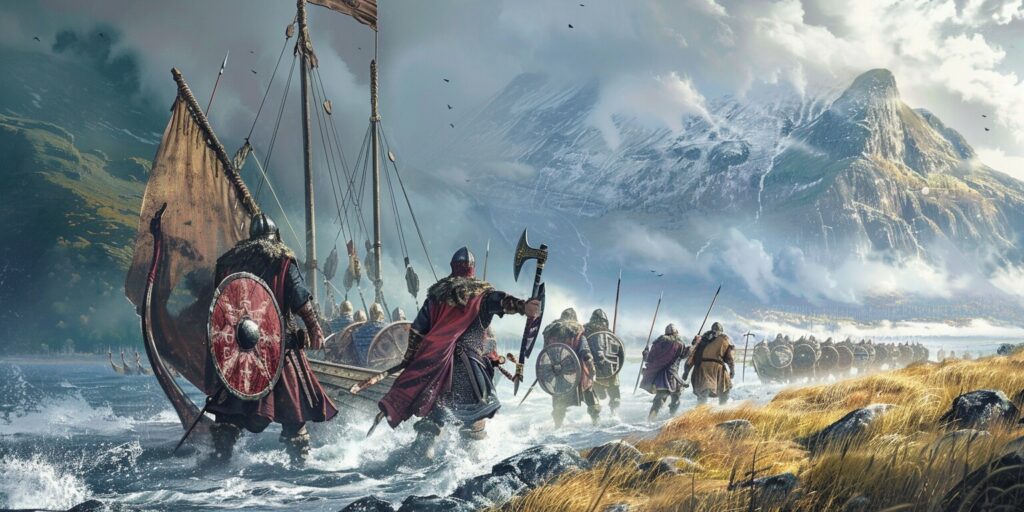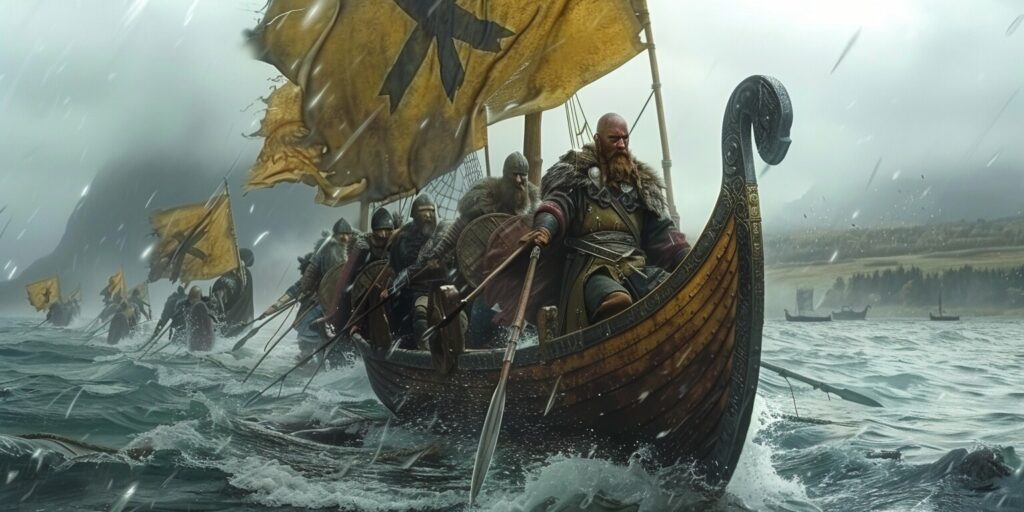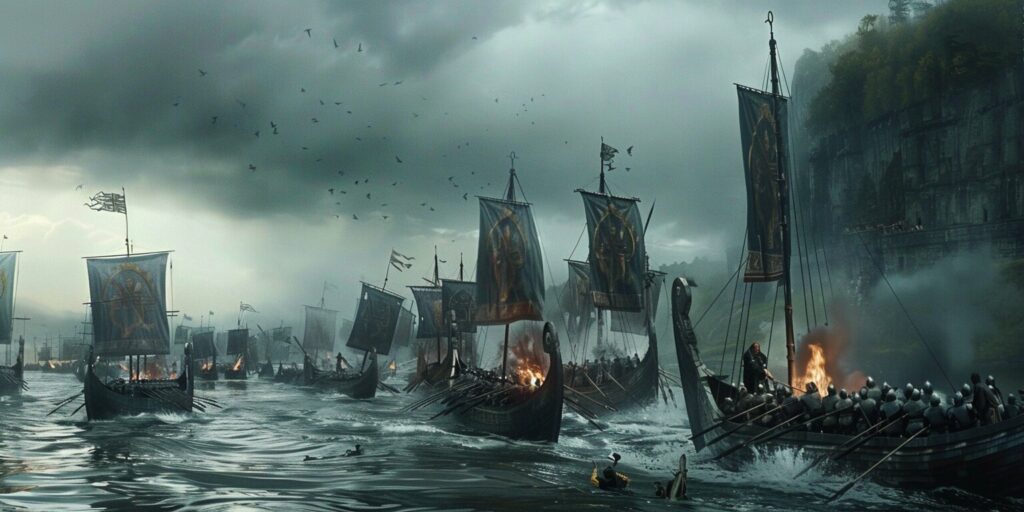Viking Raids and Warfare, Vikings
The History of Viking Raids on England
The Viking raids on England timeline started in the late 8th century, beginning the infamous Viking Age. These raids, known for hitting coastal areas like Lindisfarne in 793 AD, aimed to acquire wealth and land. The Norsemen attacked by surprise, spurring major cultural and war changes in medieval England.
The cause behind these attacks shows medieval Europe’s complex dynamics. England’s split kingdoms and internal fights made it a prime Viking target. England’s politics changed drastically as the raids switched from short hits to long invasions.
The Anglo-Saxon Chronicle and other accounts detail the Viking invasions, providing crucial insights into the Vikings’ history. They show how these events shaped England’s history. Archaeological digs also show how deeply the Vikings’ ways affected English life and culture. So, when were the viking raids on England? Let`s find out in detail in our article.
Who Were the Vikings and Their Relation to England?
The Vikings were from Scandinavia, which is now Denmark, Norway, and Sweden. They went on many journeys during the early Middle Ages, looking for wealth, land, and resources. This changed the map of Europe, especially England, shaping the history of England in the process.
Viking Origins and Expansion
Vikings were sea travelers from the cold lands of Scandinavia. They used longships to go as far as North America and Russia. Their travels were driven by issues like overpopulation and political unrest.
They were also attracted to new, fertile lands. This led to their significant presence in northern and eastern England, especially impacting the history of the Vikings.
Viking Involvement in England
The raid on Lindisfarne in 793 AD marked the Vikings’ first big impact on England. After many raids, they started to settle in England. The Vikings heavily influenced areas like Northumbria and East Anglia.
York became a major settlement. King Guthrum’s rule in East Anglia and his treaty with King Alfred of Wessex were important for Viking-English relations and the Vikings’ larger history.
Key Viking Leaders in England
Ragnar Lothbrok was a famous Viking known for invasions in England. His story is told in Norse sagas. King Sweyn Forkbeard of Denmark also made a major impact.
He became the King of England after several campaigns. These leaders demonstrate the Vikings’ military and strategic skills in England and highlight their influence during the Viking invasion.
Though often known for their raids, the Vikings made lasting cultural, trade, and governance changes in England. They had a big impact on English history.
What Were the Notable Viking Raids on England?
The Viking Age in England was a time of intense raids on its lands. Raids from places like Lindisfarne to Northumbria and East Anglia had big impacts. This section talks about three of the most famous raids and their effects on English history.
The Raid on Lindisfarne
On June 8, 793, a calm island was disrupted by Viking raiders, marking the beginning of significant Viking activity in the Vikings’ history. This attack is seen as the start of the Viking Age in England. The Vikings raided the monastery, shocking the Christian world. This event marked the start of more Viking conquests and showed England’s weak coast defenses.

The Invasions of Northumbria and East Anglia
In 865, Vikings led by Ivar the Boneless and Halfdan Ragnarsson invaded Northumbria and East Anglia. These attacks led to Northumbria and East Anglia falling under Viking rule. The invaders showed their clever tactics, strongly impacting these lands.
The Battle of Stamford Bridge
The Battle of Stamford Bridge in 1066 was a key point in the Viking invasion of England. On September 25, Harold’s army fought against Harald Hardrada and Tostig. Harold won but lost many soldiers, weakening his army for the Norman Conquest. This marked the decline of serious Viking threats, ending a major historical chapter.
How Did Viking Raids Impact Anglo-Saxon England?
Viking raids changed the course of history in Anglo-Saxon England, redefined its politics and culture, and set the stage for England’s future. The response of the Anglo-Saxon kingdoms, especially Wessex and Mercia, was key in fighting off the Vikings.
The Anglo-Saxon Resistance to Viking Invasions
The Anglo-Saxon kingdoms fought tirelessly to protect their lands. Wessex, in particular, was at the heart of the battle. They knew the Vikings were a big threat, so the Anglo-Saxons used battles and smart tactics to turn back the invaders. Their unity and clever strategies stood out during this difficult time.
The Role of King Alfred in Defending England
King Alfred was a crucial leader against the Viking threat. He made important military and government changes in Wessex, pivotal for defending against Viking raiders. Alfred built strong towns called burhs to safeguard against Viking attacks, securing the region during the Viking invasion of England. His leadership united the Anglo-Saxons, making him a hero in English history.
Consequences of Viking Raids on English Kingdoms
The Viking attacks changed more than just the battlefield. They shifted political power in Anglo-Saxon England. The constant Viking danger made Wessex a leading force, leading to the union of all English kingdoms. The Vikings also brought new customs that mixed into Anglo-Saxon life. This mixing changed England, making it stronger and more united.
What Led to the End of Viking Raids on England Timeline?
The end of the Viking raids in England was a crucial moment in Europe’s story. This change was caused by major battles and political shifts.

The Defeat of the Great Heathen Army
The Great Heathen Army, a group of Norse warriors, brought fear to England. But, in 878 at Edington, Alfred the Great beat them. This win led to their retreat and a key treaty. It marked the start of the end of Viking threats in England.
After their loss, the Vikings had to accept the Treaty of Wedmore. This weakened their power, and many Vikings were caught by the locals. With their control slipping, the area came under the Anglo-Saxons more.
The Norman Conquest and its Impact on Viking Activity
By 1066, England had greatly changed due to the Norman Conquest. William the Conqueror’s win at Hastings strengthened his rule and cut down on Viking invasions. The Normans’ control marked the official end of the Viking age.
Under Norman rule, Viking towns lost their freedom and influence, which had been prominent during the Viking invasion of England. The Normans’ firm control stopped Viking raids for good, ending the Vikings’ time in England.
Bottom Line
The Viking raids on Britain’s coasts started in the late 8th century. They brought a big change to the British Isles, marking a pivotal point in the history of England. This period, known as the Viking Age, is key in shaping what we now call England and Scotland.
The Vikings added their own traditions to British life. They left their mark through place names and DNA evidence, deeply embedding themselves into the history of England. This was also a time of new trade, sharing technology, and different governing and fighting methods.
The Vikings went from raiders to playing a big part in British society. As they settled, they helped create a stronger and more united area. Even after they were no longer ruling, their influence continued. The Viking culture became part of the British way of life and their memory is still celebrated today.

